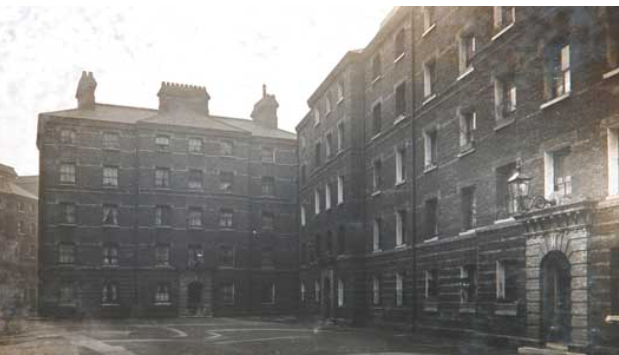b.1868-d.1917
Although his birth year was estimated incorrectly in a number of censuses and workhouse registers, our research confirms that George Camplisson was born in Dublin on the 9th of April 1868. George was baptised on the 20th April 1868 in Dublin.
George was the second child of compositor George Camplisson senior and his wife Mary Anne (née Robinson). The couple had married in Dublin on the 17th of January 1863. Their first child, a daughter called Mary Elizabeth, was born on the 6th of January 1866. At the time of George’s birth, the family was living at 168, Townsend Street.
1870s
Shortly after George’s birth the family moved to London. In the 1871 census, they are living at 37, Fetter Lane, St Dunstan in the West in the City of London. A third child, Eleanor May, was born in 1870.
1880s
By the time of the 1881 census Mary Anne has given birth to three more sons, William John, born in 1875, John Henry (1878) and Charles Edward (1880). George senior is now described as a letterpress printer while 12 year-old George is a printer’s machine boy (an assistant to a printer).
The family is now living at 16B, Peabody Buildings in Lambeth. The Lambeth Estate, in Stamford Street, was constructed in 1875 so the Camplisson family would have been among its first tenants.

The Peabody Trust was founded by an American merchant banker, George Peabody, to provide housing and support to various charitable schemes for people in need in London. Peabody Buildings were blocks of ‘Improved Model Dwellings for the respectable Working Class’ which replaced slum houses with neat, weather-proof, clean, much sought-after small flats. The living accommodation was self-contained, though kitchen areas tended to be communal for all but the most basic cooking, and sanitary provision was also in sets. All they lacked were bathrooms. The tenants were carefully selected, and were generally in steady work and not, therefore, the poorest folk.
A notable resident in the early years of the estate was Mary Ann Nichols, the first murder victim of “Jack the Ripper”. Mary lived with her husband William Nichols and their children. Following the couple’s separation, Mary moved to the Whitechapel area where she drifted into a life of prostitution before being murdered in 1888.
1890s
In the 1891 Census, we find the Camplissons have moved to 3, William Street in Clerkenwell and the younger George, now aged 22, is a printer’s apprentice.
Just four years later, when he was living at 7, Roberts Place in Clerkenwell, we see the first evidence of the mental health problems that would dominate George’s later life. On the 12th of June 1895, he was admitted to City Road Workhouse in Holborn, described as ‘insane,’ and then transferred to Caterham Asylum on the 4th of July. We do not know the nature of his mental illness or how long he remained in the asylum.
1900s
By 1901, George had moved to another Peabody property in Clerkenwell, with his now widowed mother and his brothers John and Henry. George senior had died in 1899. We do not know if George was working at the time but he is described in the census as a ‘pressman’, a colloquial term for a printing machine operator. John is a ‘gold blocker’, gold blocking being the process of embossing a surface, such as a book cover, with gold leaf. Henry is a porter and packer of china goods.
In 1906, George’s stays in workhouses became more frequent as, one must assume, his mental health deteriorated.
- At the end of November 1906, George’s mother Mary Anne died. On the 21st of December, George was admitted to the St Pancras Workhouse in Camden from the home of his sister, Mrs Mary Rutherford at 97, Park Street in Camden. He remained there until the 16th of January 1907 when he was discharged at his own request.
- He was readmitted to the St Pancras Workhouse on the 13th of June 1907. A month later, on the 19th of July, he transferred to the City Road Workhouse in Holborn where he spent one night. We do not know where George lived between his stays in the workhouse. The registers to which we have access state that his address is ‘unknown’. In the one instance of the name of a next-of-kin being given there are no details other than ‘brother address unknown’.
- On the 28th of October 1909 George entered the City Road Workhouse, Holborn and was discharged at his own request on the 2nd of November.
1910s
The pattern continues into the next decade:
- In 1910 he had two stays in the Westminster Union Workhouse, from the 11th of February to the 12th of March and from the 25th of November to the 14th of December.
- On the 18th of January 1911, he was readmitted to the Westminster Union Workhouse. Just over a week later, on the 27th of January, he was transferred to Long Grove where he was to remain for the rest of his life.
In the 1911 census George is a patient in Long Grove. Although his former occupation is correctly given as ‘printer’, all other details, including his place of birth are ‘not known’.
Sadly, George died in Long Grove in the second quarter of 1917. He was buried in plot 1287b in Horton Cemetery on the 4th of May 1917.
William’s family after his death
Apart from William, who died in 1908, all George’s other siblings survived him: Eleanor died in 1929, John in 1935, Charles in 1945, Mary in 1958 and Henry in 1962 (in British Columbia). We do not know if any of George’s siblings maintained contact with him while he was in Long Grove.
Written by Stephen Munday December 2021


